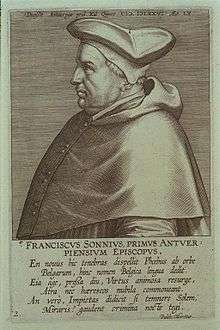Franciscus Sonnius
Franciscus Sonnius (12 August 1506 – 30 June 1576) was a theologian during the time of the contrareformation, an advisor of the pope and the first bishop of Bois-Le-Duc and later of Antwerp. His real name was Van de Velde, but in later years he called himself after his native place, Son in Brabant. He came from the same noble family as philosopher Heymeric de Campo. The family has three golden mill-irons in their coat-of-arms, a sign that is depicted on the chair of the first bishop in the cathedral of Antwerp.

Life
Sonnius was born in Son. He went to school in 's-Hertogenbosch and Leuven, and afterwards studied medicine for a time, then theology; in 1536 he received the licentiate and in 1539 the doctorate in theology. After labouring for a short time as a parish priest at Meerbeek and Leuven, he became professor of theology at the Catholic University of Leuven in 1544, and attended the Council of Trent in 1546, 1547, and 1551. He was sent to the council first by Bishop Karl de Croy van Doornik, then by Maria of Castile, Queen of Hungary, the regent of the Netherlands.
In 1557 he also took an active part in the religious disputation of Worms. Not long after this Philip II of Spain sent him to Rome to negotiate with Pope Paul IV in regard to ecclesiastical matters in the Netherlands, especially as to increasing the number of dioceses and separating the Belgian monasteries from the German, as in the latter the Reformation was rapidly spreading. In acknowledgment of his success, he was appointed Bishop of 's-Hertogenbosch in 1566, but he was not consecrated until two years later, by Cardinal Granvella.
In 1569 he was appointed the first Bishop of Antwerp and in the following year came into possession of his diocese. He founded an ecclesiastical court and visited all the parishes of his diocese. He proclaimed the decisions of the Council of Trent and established regular meetings of the deaneries. As Bishop of Antwerp, he held two diocesan synods, setting an example that exerted influence beyond the boundaries of the archbishopric of Mechlin. He resided in Antwerp until his death in 1576, aged 69. In 1616 the cathedral chapter and the city erected a monument to him.
Works
He opposed Calvinism and wrote for this purpose a clear summary of its teachings for the use of the clergy, under the title Succincta demonstratio errorum confessionis Calvinistae recenter per has regiones sparsae (Louvain, 1567). He also wrote a textbook of dogmatics: Demonstrationum religionis christianae libri tres (Antwerp, 1564), to which in 1577, after his death, a fourth book was added, De sacramentis.
References
- Gils and Coppens, Nieuwe beschrijving van het bisdom van's Bosch, I (Bois-le-Duc, 1840), 218; Allge. deutsche Biog., XXXIV.
External links
 Herbermann, Charles, ed. (1913). "Franciscus Sonnius". Catholic Encyclopedia. New York: Robert Appleton Company.
Herbermann, Charles, ed. (1913). "Franciscus Sonnius". Catholic Encyclopedia. New York: Robert Appleton Company.
![]() This article incorporates text from a publication now in the public domain: Herbermann, Charles, ed. (1913). "Franciscus Sonnius". Catholic Encyclopedia. New York: Robert Appleton.
This article incorporates text from a publication now in the public domain: Herbermann, Charles, ed. (1913). "Franciscus Sonnius". Catholic Encyclopedia. New York: Robert Appleton.
